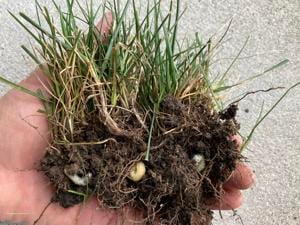Now that summer is here, it is a perfect time to start planning your backyard vegetable garden. Almost every gardener has seen grub larvae in the soil while installing new plants or tilling the vegetable garden. The term "white grub" actually encompasses the larval stage of several scarab beetles, the most common and most damaging being the June beetle/masked chafer and the Japanese beetle.
Less well-known, are the May/June beetle and green June beetle. All have a grub larval stage that can cause damage to turfgrass. The grubs are off-white, with six legs located just behind their reddish-brown head and are usually found curled into a "C" shape in the soil.

Adult June beetles are stout-bodied, oval-shaped insects, about a half-inch in length and dark yellow to light brown in color. They are most active at night, often flying around lights. Unlike other scarab beetles, June beetles do not feed on plants as adults.
Japanese beetle adults are slightly smaller, only three-eighths inches in length, with a dark metallic green head and coppery-brown body. They also have five tufts of white hairs on the sides of their abdomen. Both masked chafers and Japanese beetles have a one-year life cycle.
Japanese beetles do feed as adults and can cause severe damage to a wide range of landscape plants. Roses, oaks and cherries are a few of their preferred plants and can suffer significant defoliation. No.
Newly established lawns and low-maintenance lawns usually have few problems with grubs. T.















![Ganesh Chaturthi 2024: Kareena Kapoor, Saif Ali Khan twin in red for Ambani Ganpati darshan [PHOTOS]](https://static-gi.asianetnews.com/images/01j77mq7b6rc53pxwtmxzf59va/fotojet--33-.jpg)



